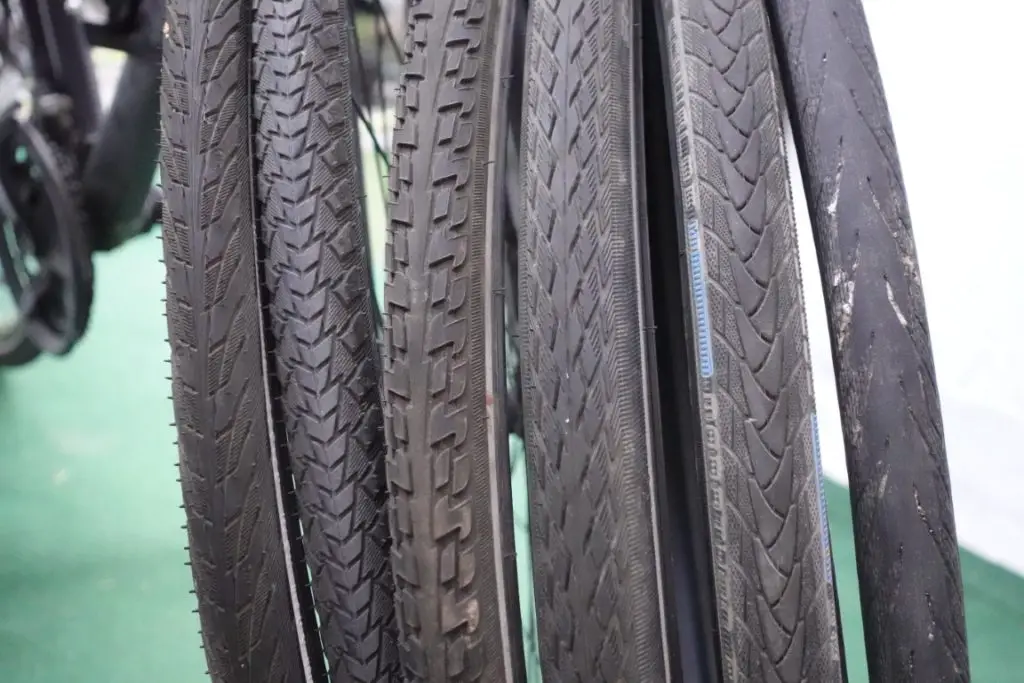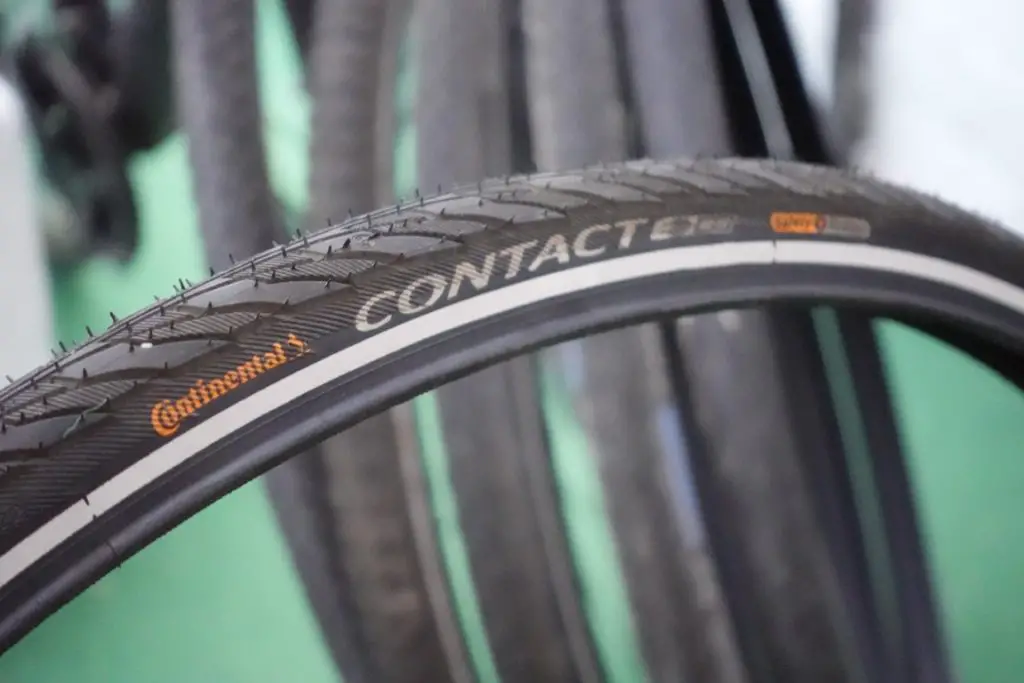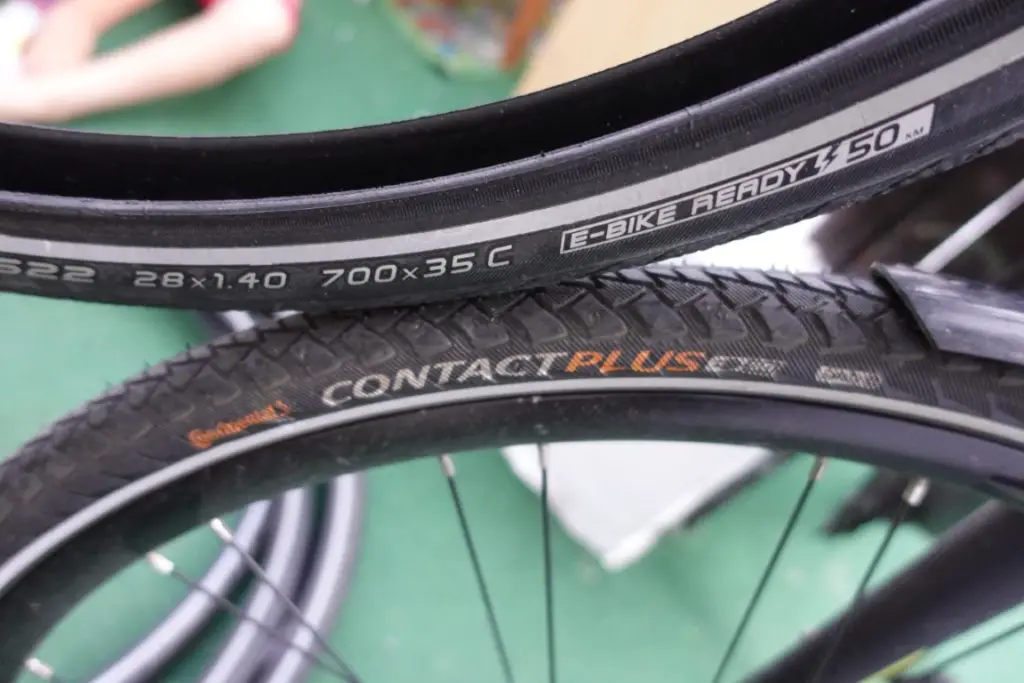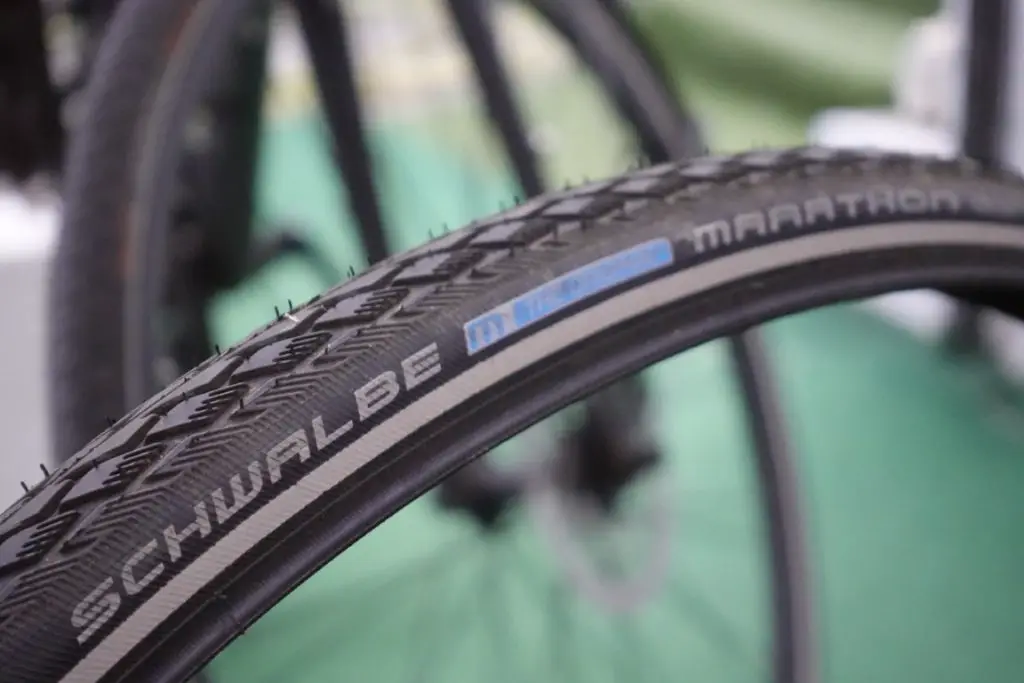As a serious bike commuter, you want to ride in comfort, and you’ll want to avoid punctures as much as possible. But which tire represents the best value? I spent a lot of money and time testing the most regarded commuter tires. Here is a detailed comparison of the six best commuter tires money can buy.
The six tires I am showing you are:
- Continental Contact
- Continental Contact Plus
- Continental Ride Tour
- Schwalbe Marathon
- Schwalbe Marathon Plus
- Schwalbe Marathon GT
I have the 32mm version of each of these tires except the Schwalbe Marathon GT, where I used the 37 mm version. I believe this is the smallest you can get in the GT.
32 mm is the best tire width for commuting because it offers sufficient cushioning, so it absorbs the road buzz, and it’s not too bulky to slow you down because of its excessive weight.
Electric bikes built for everything and priced for everyone. Shop Rad Power Bikes, America's #1 electric bike brand. Get out. Go further. Ride Rad.
All of these tires have reflective sidewalls, which make them stand out at night and are very safe to ride at night. Every commuter bike needs to have these, in my opinion.
They all have their strengths and weaknesses and try to strike the right balance yet appeal to a different type of user.
If you are looking for a robust tire that’s also budget-friendly, get the Continental Ride Tour. If you have more money to spend, get the Continental Contact Plus. These two tires are my personal favorites as they represent the best value for money.
Here’s a quick recap of the results of my extensive testing.
| Contact | Contact Plus | Ride Tour | Marathon | Marathon Plus | Marathon GT | |
| Weight | 510g | 740g | 670g | 640g | 870g | 770g |
| Weight points | 4 | 3 | 3 | 3 | 2 | 3 |
| Speed and agility | 4 | 3 | 4 | 4 | 2 | 2 |
| Comfort | 3 | 4 | 4 | 4 | 4 | 5 |
| Grip | 5 | 5 | 4 | 4 | 3 | 4 |
| Versatility – surface | 3 | 5 | 5 | 4 | 3 | 3 |
| Durability | 4 | 4 | 3 | 4 | 4 | 3 |
| Ebike ready | 3 | 5 | 3 | 3 | 3 | 5 |
| Puncture protection | 2 | 5 | 3 | 4 | 5 | 4 |
| Ease of mounting | 3 | 1 | 2 | 3 | 2 | 3 |
| 31 | 35 | 31 | 33 | 28 | 32 | |
| Price per tire | $ | $$ | $ | $$ | $$$ | $$$ |
Here’s a detailed description of each category.

Weight
Weight is an essential aspect for many riders who want their bike to be as light as possible. Since these tires are in the commuter range and have at least some puncture protection, they will not be as light as racing tires, where each gram counts. In my view, a heavy tire is not a huge penalty on a commuter bike, which needs to be functional, comfortable, and durable.
- Continental Contact: 510g
- Continental Contact Plus: 740g
- Continental Ride Tour: 670g
- Schwalbe Marathon: 640g
- Schwalbe Marathon Plus: 870g
- Schwalbe Marathon GT: 770g

Unsurprisingly, the Continental Contact is the lightest tire since it offers the least amount of puncture resistance. The protective belt built into the tire defines how heavy a tire will be for the most part. It’s a balance of costs and benefits.
Even when you handle the tires off the bike, you will notice how heavy the Marathon Plus is, but of course, this comes with the great benefit of very high protection.
Note that if the Marathon GT existed in a 32mm version, it would probably be a good 40g lighter.

- Continental Contact: 4
- Continental Contact Plus: 3
- Continental Ride Tour: 3
- Schwalbe Marathon: 3
- Schwalbe Marathon Plus: 2
- Schwalbe Marathon GT: 3
Speed and agility
I was curious to see if and how much the weight of these tires affected their speed. I tested this on a local hill.
I rode the same bike with the exact same setup on the same hill three times. I measured the time it took to get both up and down and averaged them out. On the way down I didn’t pedal at all, but I let gravity take care of the speed.
| Contact | Contact Plus | Ride Tour | Marathon | Marathon Plus | Marathon GT | |
| Avg. time up | 3:55 | 4:01 | 3:42 | 3:45 | 4:29 | N/A |
| Avg. time down | 4:25 | 3:45 | 3:36 | 3:47 | 3:50 | N/A |
What stands out to me is that the weight of the tires comes into play much less than I expected, so much so that you can’t even tell the difference based on this experiment.
I didn’t use a power meter to measure my output on the way up, so that could explain why the up times were less consistent, but the average time down is also very curious as Continental Contact, which is the lightest tire, ran the slowest.
Since I ran these tests on different days, other factors, such as slight differences in tire pressure, temperature, wind, and humidity, played a much more important role in determining my average speed.
Agility is another, much more important factor to consider than speed because it’s clearly noticeable as you switch between tires. I didn’t find an empirical way to measure this, so it’s based on perception. Here, the weight comes into play a great deal.
- Continental Contact: 4
- Continental Contact Plus: 3
- Continental Ride Tour: 4
- Schwalbe Marathon: 4
- Schwalbe Marathon Plus: 2
- Schwalbe Marathon GT: 2
All of these tires are made for commuting and touring, where nimbleness is not such a high priority as it is on racing bikes. I felt that lighter tires are more responsive and make handling the bike just a bit faster.
The Marathon Plus is very heavy and rides like a tank. It rolls through road imperfections with ease because of its weight and body mass, but when you make small sudden corrections, you can feel that it’s not as nimble as its lighter counterparts.
The Contact Plus stands out to me as an interesting tire here because it is quite agile for its weight. I really like how it strikes the right balance of weight and agility.

Comfort
As a commuter, you may spend up to an hour or even more on your bike each way, which means that you need your bike to be as comfortable as possible. This starts with the tire, especially if your bicycle – like mine – doesn’t have a suspension fork.
- Continental Contact: 3
- Continental Contact Plus: 4
- Continental Ride Tour: 4
- Schwalbe Marathon: 4
- Schwalbe Marathon Plus: 4
- Schwalbe Marathon GT: 5
The harder a tire needs to be inflated the more road buzz it transmits. Since the Continental Contact has the least amount of puncture resistance, you need to make sure that you run it at a sufficiently high pressure so you avoid getting flats. This means that it’s going to offer the least amount of comfort. This has been true in my case. Don’t get me wrong; even this tire is well-comfortable compared to a skinny 23 mm rock-hard tire.
The rest of the tires are well protected against flats, so I felt comfortable running them even at lower pressures, which made them slightly more comfortable.
The Marathon GT stands out since it has the most air volume, being 37 mm wide.

Grip
If you want to be in control of your bike, you need tires that offer sufficient grip as you corner and brake. I ran several tests on a variety of surfaces, and I was quite happy with them.
- Continental Contact: 5
- Continental Contact Plus: 5
- Continental Ride Tour: 4
- Schwalbe Marathon: 4
- Schwalbe Marathon Plus: 3
- Schwalbe Marathon GT: 4
I felt in control with these tires most of the time. The Marathon Plus loses traction on wet slippery surfaces the easiest, but I didn’t feel unsafe or unable to turn or stop.

Versatility
Most people who purchase these tires are going to use them mostly on paved roads with the occasional single-track use. The tread pattern ranges from barely any (Marathon GT) to really good. The better the pattern, the more useful the tire is for off-road use.
You’re not going to win gravel races with any of these tires, but the Continental Ride tour and the
I was surprised to see that the Schwalbe Marathon has a better pattern and offers better off-road riding than the Marathon Plus. In my opinion, this would make more sense the other way around.
- Continental Contact: 3
- Continental Contact Plus: 5
- Continental Ride Tour: 5
- Schwalbe Marathon: 4
- Schwalbe Marathon Plus: 3
- Schwalbe Marathon GT: 3
Durability
Durable tires need to be replaced less often and have a longer lifespan.
Not being able to ride 1000s of miles with each of them to see which one lasted longer, I did some skidding tests with each of them and observed how much the surface was worn at the end. This is an indicator of how they compare in real life.
I also spent time researching other people’s experiences and how much they were able to ride them before they needed to replace them.
I spent the most time with the Continental Ride Tour as it was my daily commuter tire for over 2 years and 4,000 miles. I had to replace my rear tire after 3500 miles, but the sidewalls started cracking just after a few weeks of use. It didn’t affect the riding experience, and it didn’t result in punctures, but it’s something to keep in mind.
- Continental Contact: 4
- Continental Contact Plus: 4
- Continental Ride Tour: 3
- Schwalbe Marathon: 4
- Schwalbe Marathon Plus: 4
- Schwalbe Marathon GT: 4
E-bike ready
You can mount all of these tires on e-bikes. The Marathon GT and the Contact Plus are rated the highest, at 50 km/h (30 mph), while the rest of them can be used on normal pedelec bikes up to 25 km/h (15 mph).
This isn’t a deal-breaker for most people, but if you’re looking for new tires for your e-bike, it is an essential detail to pay attention to.
- Continental Contact: 3
- Continental Contact Plus: 5
- Continental Ride Tour: 3
- Schwalbe Marathon: 3
- Schwalbe Marathon Plus: 3
- Schwalbe Marathon GT: 5
I also own the 37 mm version of the Schwalbe Marathon Plus, rated at 50 km/h (30 mph). It seems that the larger Marathon Plus tires have a higher e-bike rating.

Puncture protection
These tires are among the best in their class regarding puncture protection, which makes them very dependable and great for commuting.
Pay close attention to this detail if you encounter many thorns or sharp glass on your route to work. A puncture-proof tire can save you a lot of time and headaches.
- Continental Contact: 2
- Continental Contact Plus: 5
- Continental Ride Tour: 3
- Schwalbe Marathon: 4
- Schwalbe Marathon Plus: 5
- Schwalbe Marathon GT: 4
If puncture protection is your main concern, I can recommend both the Schwalbe Marathon Plus and the
I give a slight edge to the Contact Plus because I could ride it with ten thumb-tacks in the tire, and it didn’t lose any pressure, while the Marathon Plus had a flat when I removed one of them.
If you look at each diaphragm, you will notice that the Contact Plus has an additional Kevlar belt under the protective rubber.
The Continental Contact only gets a 2, but it’s still a perfect tire, which didn’t cause me any problem, but it doesn’t offer that extra protective layer that all the others do. If you ride mostly on urban roads without too much debris, it is an excellent tire that won’t disappoint you.
Ease of mounting
Most of the time, we don’t think how easy it is to mount the tire as long as we don’t have to do it. But even the most protective tire may need to be taken off some time.
In my experience, none of these tires were straightforward to mount, probably because they are all wire bead tires. Folding tires stretch easier, so they are easier to put on the rim.
I had to use tire levers for all despite watching several people on YouTube putting them on with their bare hands.
- Continental Contact: 3
- Continental Contact Plus: 1
- Continental Ride Tour: 2
- Schwalbe Marathon: 3
- Schwalbe Marathon Plus: 2
- Schwalbe Marathon GT: 3
I had terrible difficulties getting one of the Contact Plus tires on the rim. The process took me more than I could admit (ahm. 60 minutes), and I punctured my inner tube five times. Thankfully, I was at home under no time pressure and with plenty of patches and spare inner tubes.
The Ride Tour and the Marathon are both difficult tires to mount, in my experience. The rest of them were neither too easy nor too hard. With practice and skill, they get easier.

Price and value
I paid the following amounts for these tires. I realize that these prices change over time, and these tires have become much more expensive recently, but they haven’t changed relative to each others’ prices.
- Continental Contact: $18.5
- Continental Contact Plus: $26.6
- Continental Ride Tour: $15
- Schwalbe Marathon: $21.85
- Schwalbe Marathon Plus: $28.65
- Schwalbe Marathon GT: $28
Let’s tally up the points first to see how much each is worth the price.
| Contact | Contact Plus | Ride Tour | Marathon | Marathon Plus | Marathon GT | |
| Weight | 510g | 740g | 670g | 640g | 870g | 770g |
| Weight points | 4 | 3 | 3 | 3 | 2 | 3 |
| Speed and agility | 4 | 3 | 4 | 4 | 2 | 2 |
| Comfort | 3 | 4 | 4 | 4 | 4 | 5 |
| Grip | 5 | 5 | 4 | 4 | 3 | 4 |
| Versatility – surface | 3 | 5 | 5 | 4 | 3 | 3 |
| Durability | 4 | 4 | 3 | 4 | 4 | 3 |
| Ebike ready | 3 | 5 | 3 | 3 | 3 | 5 |
| Puncture protection | 2 | 5 | 3 | 4 | 5 | 4 |
| Ease of mounting | 3 | 1 | 2 | 3 | 2 | 3 |
| 31 | 35 | 31 | 33 | 28 | 32 | |
| Price per tire | $18.5 | $26.6 | $15 | $21.85 | $28.65 | $28 |
These tires are all great, but considering the overall performance and the price point, the Continental Contact and the Continental Ride Tour represent exceptional value. The fact that they are cheap doesn’t mean that they are cheapish.
Sure, if you’re looking for absolute puncture protection, they are not the best choice, but they don’t fall behind the pack. The Marathon Plus ended up with the least points, which was a big surprise to me.
Considering the overall performance and the price of these tires, they deserve the following points for value:
Continental Contact: 5
Continental Contact Plus: 4
Continental Ride Tour: 5
Schwalbe Marathon: 4
Schwalbe Marathon Plus: 3
Schwalbe Marathon GT: 3

Which one should you get?
If you’re looking for a tire for a very specific use, and any one of the above criteria is important to you, you can pick the tire that best suits your needs.
If you’re like me, who rides on mostly decent roads and wants a good commuter tire, any one of them is a good fit. Even if your budget only allows for the cheapest Continental Ride Tour, you won’t be disappointed.
My personal favorite is the Continental Contact Plus. It is a great tire overall, and it performs best in most circumstances. If money isn’t an issue, I recommend it without hesitation.
Happy pedaling!
